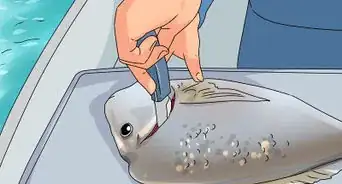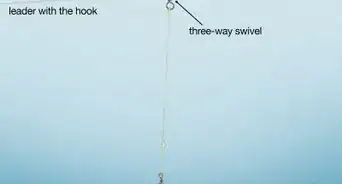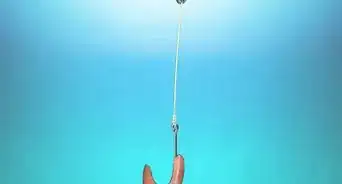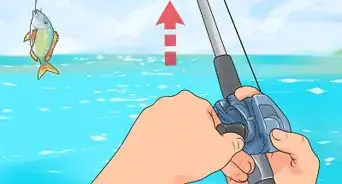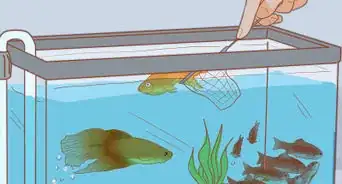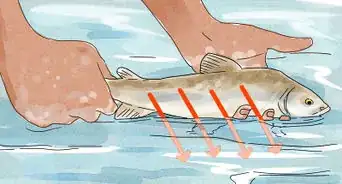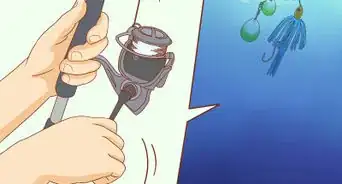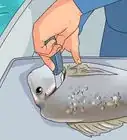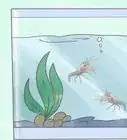wikiHow is a “wiki,” similar to Wikipedia, which means that many of our articles are co-written by multiple authors. To create this article, 10 people, some anonymous, worked to edit and improve it over time.
This article has been viewed 32,197 times.
Learn more...
Fishing is one of those sports that get a lot of exposure in media and television. However, if you've tried starting to fish, you probably know there are a lot sources to learn about the sport that are either too vague or too complex for a beginner. If you're just starting out with fishing, dive in a step 1, below.
Steps
Preparing to Fish
-
1Research areas for fishing. There are plenty of fish in the sea, but finding the right area could mean more specific catches, better catching probability, or even a friendlier community to help enjoy the trip.
- For people who live on the coast, saltwater fishing is an easy pick for them. They will probably already have several popular sites around them. Generally the most popular among them would be a great place to start as it would have the most community built around it as well as contain a probable good fish population.
- For the more landlocked areas, finding a spot may just involve asking around with locals or at fishing shops of any kind. People who regularly fish tend to be very friendly and eager to show what they know to beginners.
-
2Investigate good times to go fishing. After you've found a place, the timing should be accounted for as well. For example, plenty of people tend to fish around dawn or dusk as these are peak feeding times for fish.Advertisement
-
3Make sure you have the permissions needed. Localized fishing licenses are required in order to fish and take your catch home. These licenses can be obtained from the local Department of Fish and Wildlife centers
- However, many more private or commercial fishing areas exist where admission is charged in order to enter and fish. These such places include that permission within their cost, making them cheaper than a license for occasional trips.
-
4Grab the right reel and rod for you. As long as the line is medium in length and flexible, it should do fine for beginners. For now, these details shouldn't concern you too much until you enjoy the sport, are familiar with it, and are ready to invest in better equipment. For now, the basics will do just fine.
- Prices will vary, but getting the rod from a regular big-box retailer would probably do you much more than going to a specialty store. Try to get a bundle that comes with its own reel and tackle box as you can use these to learn which tools you want to use continuously.
-
5Prepare your bait. As for bait, live, fake, and dead bait are all options for you to buy. These are all fine for now as you will eventually learn how to use other tools to catch your own bait later. In addition, it is useful to get over any squeamishness on dead bait before you move on to live bait.
- If you are going to be using live bait, be aware of the need to contain them in some sort of storage and keep them alive by either cycling water within the storage or using an air pump to pump oxygen back into the water. Otherwise, the bait will die in several minutes.
Going Fishing
-
1Prepare your line. Preparing your line with the appropriate bait and tools can take some time to learn as different items have different uses and knowing which to use takes some familiarity with their effects on the line.
- Tying the knots in lines may require some certain special kinds of knots. A basic one that is useful to learn as well as easy is the J knot, which can be best learned with a short supplemental video tutorial search.
- Sinkers, or weights, are used to give the line more inertia against currents in order to sop your hook from just floating on the surface.
- Bobbers are used for visibly seeing your line and any potential bites tugging down on it.
- Baiting a hook may not be the most pleasant task, but bait should usually be hooked several times for security. However, it should look natural as animals would not aim for dead looking fish and like to only bite live-looking bait.
-
2Cast the line. For both the main types of reels, the technique is the same. Both reels have a locked and released phase for its line. The general technique is to unlock the line and hold it with your fingers and then swing your rod in an arc, letting go of the line at the peak of the arc. The momentum should cause the hook (if it's heavy enough) to fly. As it sinks, the line should be locked as to not let the string fall loose around the real or to let a fish just walk away with your hook.
-
3Wait for a fish. Patience is a well-known attribute to fishing, but is a bit exaggerated. Don't be impatient with your rod, after about leaving it for about 15 minutes, it is a good idea to take it out and recast it. It may need to be baited again, so leaving it in longer than that could be a waste of time.
- Getting used to how tugs feel will take some time as smaller fish tugs may act differently, but be the same strength as the waves or the wind on your sinker or line.
- When you feel a tug, your first instinct should be pulling your rod upwards, pushing the hook further into the catch. This functions as to secure the hook in the fish.
- Reeling in the line should not just be done with only the reel. The reel may not be strong enough to pull in the larger fish. Appropriate reeling requires the fisherman to pull back the rod and reel in the slack created by the pull. Doing this repeatedly ensures the fight to pull on the rod itself and not the small reel.
-
4Decide what to do with your fish. Once a fish is caught, what to do with it is only somewhat up to you. Releasing it back is always an option, but in order to keep the catch, some further identification is required. There are size and species regulations that should be explained to you as you get your license that require you to release some fish depending on their age (determined by size) and species. If you are keeping the fish, the appropriate containers should be accounted for.
Community Q&A
-
QuestionHow do I put a lure on the line?
 Mr fishermanCommunity AnswerTie it on with a good fishing knot, or invest in a snap swivel so that you don't have to tie knots every time you change lures.
Mr fishermanCommunity AnswerTie it on with a good fishing knot, or invest in a snap swivel so that you don't have to tie knots every time you change lures.
Warnings
- Also, when casting, be wary of other peoples lines and where they are so as to not intertwine or tangle the lines. This is the only thing fisherman really hate...that, and fish-stealing dolphins.⧼thumbs_response⧽
- Always be wary with hooks as small pricks are harmless while they can be pulled further in by accident, essentially hooking you and causing a greater deal of trouble getting out. Hooks are meant to make it tough for them to get shaken off a fish, making it hard to get them out of us too.⧼thumbs_response⧽
- Also, fish have teeth. Be wary!⧼thumbs_response⧽
About This Article
To fish, head out at dawn or dusk, which are peak feeding times for fish. When you get to the water, bait your hook with live, dead, or fake bait. You can also add sinkers to your line to drop your bait deeper in the water or a bobber to make your line more visible. When your line is ready, unlock it and swing your rod through the air in an arc, letting go of the line at the peak of the arc. Then, wait. If you don’t catch anything after 15 minutes, try recasting your line in another spot for some better luck! To learn how to find a good fishing spot and get any required licenses or permits, keep reading!
-Step-1-Version-2.webp)
-Step-2-Version-2.webp)
-Step-3-Version-2.webp)
-Step-4-Version-2.webp)
-Step-5-Version-2.webp)
-Step-6-Version-2.webp)
-Step-7-Version-2.webp)
-Step-8-Version-2.webp)
-Step-9-Version-2.webp)
